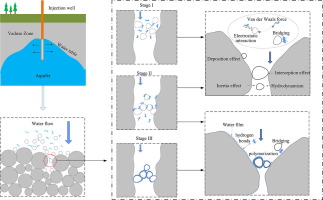当前位置:
X-MOL 学术
›
J. Hydrol.
›
论文详情
Our official English website, www.x-mol.net, welcomes your feedback! (Note: you will need to create a separate account there.)
Clogging evolution in porous media under the coexistence of suspended particles and bacteria: insights into the mechanisms and implications for groundwater recharge
Journal of Hydrology ( IF 6.4 ) Pub Date : 2020-03-01 , DOI: 10.1016/j.jhydrol.2020.124554 Huan Wang , Jia Xin , Xilai Zheng , Min Li , Yunhai Fang , Tianyuan Zheng
Journal of Hydrology ( IF 6.4 ) Pub Date : 2020-03-01 , DOI: 10.1016/j.jhydrol.2020.124554 Huan Wang , Jia Xin , Xilai Zheng , Min Li , Yunhai Fang , Tianyuan Zheng

|
Abstract Artificial recharge of groundwater is an effective strategy for supplementing groundwater resources. It is noteworthy that most artificial recharge facilities suffer from clogging problems, which mainly result from suspended particles or bacteria in the recharge water. In this study, percolation experiments in sand columns were used to investigate the combined effects of suspended particles and bacteria on the permeability of porous media, which has been ignored in the past. During the recharge process, it took a much shorter period of time (3 h) for a particle-bacteria group (PBG) to achieve a relative hydraulic conductivity of 0.30 compared with a particle-only group (PG) (28 h) and a bacteria-only group (BG) (3.5 h). A combination of relevance analysis, pathway analysis, electron microscopy, and high-throughput sequencing were employed to identify the key controlling factors in the occurrence of clogging and the governing mechanisms under the co-existence of particles and bacteria. The dominant genera of the PBG included Acinetobacter, Sphingobacterium, Comamonas and Elizabethkingia. These microbes displayed a poor ability for movement and high adhesion, which facilitated the clogging process for the PBG. The results indicated that bacterial cell growth and particle accumulation contributed to a reduction in K’ both separately and interactively during the recharge process (0–3 h), but that polysaccharide produced by bacteria began to have an impact during the later stages (stage II: 0.5–1 h and stage III: 1–3 h). The development of clogging in the PBG was primarily controlled by van der Waals forces, electrostatic repulsion and bridging during stage I (0–0.5 h). During the later stages, hydrogen bonds and polymerization of extracellular polymeric substances became the governing factors. These results provide an evaluation of clogging under the coexistence of suspended particles and bacteria, having implications for field-based artificial recharge.
中文翻译:

悬浮颗粒和细菌共存下多孔介质的堵塞演变:对地下水补给机制和影响的洞察
摘要 地下水人工补给是补充地下水资源的有效策略。值得注意的是,大多数人工补给设施都存在堵塞问题,主要是补给水中的悬浮颗粒或细菌造成的。本研究采用砂柱渗流实验来研究悬浮颗粒和细菌对多孔介质渗透性的综合影响,而这在过去一直被忽视。在补给过程中,颗粒-细菌群 (PBG) 达到 0.30 的相对水力传导率与仅颗粒群 (PG) (28 小时) 相比需要更短的时间 (3 小时) 和纯细菌组(BG)(3.5 小时)。相关分析、通路分析、电子显微镜的组合,并采用高通量测序方法确定了堵塞发生的关键控制因素以及颗粒与细菌共存下的调控机制。PBG 的优势属包括不动杆菌属、鞘氨醇杆菌属、毛单胞菌属和伊丽莎白金氏菌属。这些微生物表现出较差的运动能力和高粘附性,这促进了 PBG 的堵塞过程。结果表明,细菌细胞生长和颗粒积累在补给过程中(0-3 小时)单独和相互作用地导致 K' 降低,但细菌产生的多糖在后期(阶段 II)开始产生影响。 :0.5-1 小时和 III 期:1-3 小时)。PBG 中堵塞的发展主要由范德瓦尔斯力控制,第一阶段(0-0.5 小时)的静电排斥和桥接。在后期,氢键和胞外聚合物的聚合成为主导因素。这些结果提供了悬浮颗粒和细菌共存下的堵塞评估,对基于现场的人工补给具有影响。
更新日期:2020-03-01
中文翻译:

悬浮颗粒和细菌共存下多孔介质的堵塞演变:对地下水补给机制和影响的洞察
摘要 地下水人工补给是补充地下水资源的有效策略。值得注意的是,大多数人工补给设施都存在堵塞问题,主要是补给水中的悬浮颗粒或细菌造成的。本研究采用砂柱渗流实验来研究悬浮颗粒和细菌对多孔介质渗透性的综合影响,而这在过去一直被忽视。在补给过程中,颗粒-细菌群 (PBG) 达到 0.30 的相对水力传导率与仅颗粒群 (PG) (28 小时) 相比需要更短的时间 (3 小时) 和纯细菌组(BG)(3.5 小时)。相关分析、通路分析、电子显微镜的组合,并采用高通量测序方法确定了堵塞发生的关键控制因素以及颗粒与细菌共存下的调控机制。PBG 的优势属包括不动杆菌属、鞘氨醇杆菌属、毛单胞菌属和伊丽莎白金氏菌属。这些微生物表现出较差的运动能力和高粘附性,这促进了 PBG 的堵塞过程。结果表明,细菌细胞生长和颗粒积累在补给过程中(0-3 小时)单独和相互作用地导致 K' 降低,但细菌产生的多糖在后期(阶段 II)开始产生影响。 :0.5-1 小时和 III 期:1-3 小时)。PBG 中堵塞的发展主要由范德瓦尔斯力控制,第一阶段(0-0.5 小时)的静电排斥和桥接。在后期,氢键和胞外聚合物的聚合成为主导因素。这些结果提供了悬浮颗粒和细菌共存下的堵塞评估,对基于现场的人工补给具有影响。


























 京公网安备 11010802027423号
京公网安备 11010802027423号